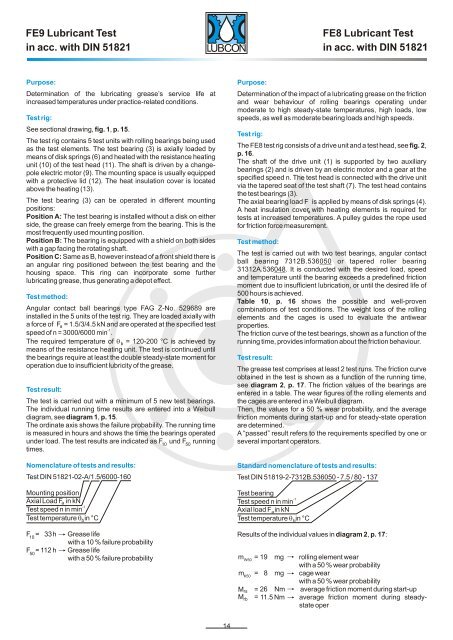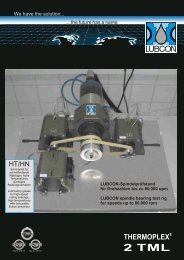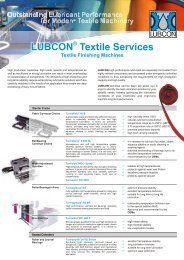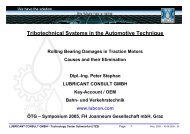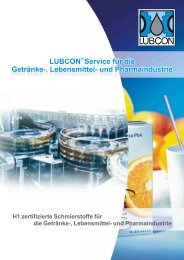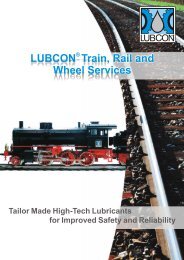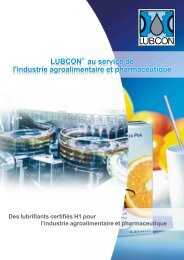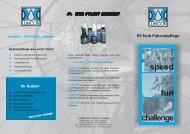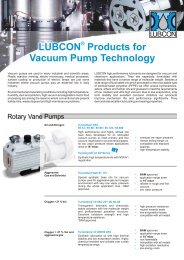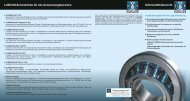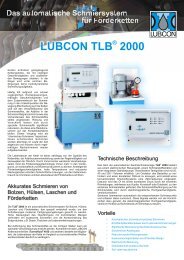LUBCON Greases for Bearings Subject to Extreme Loads - eng ...
LUBCON Greases for Bearings Subject to Extreme Loads - eng ...
LUBCON Greases for Bearings Subject to Extreme Loads - eng ...
Create successful ePaper yourself
Turn your PDF publications into a flip-book with our unique Google optimized e-Paper software.
FE9 Lubricant Test FE8 Lubricant Test<br />
in acc. with DIN 51821<br />
in acc. with DIN 51821<br />
Purpose:<br />
Determination of the lubricating grease’s service life at<br />
increased temperatures under practice-related conditions.<br />
Test rig:<br />
See sectional drawing, fig. 1, p. 15.<br />
The test rig contains 5 test units with rolling bearings being used<br />
as the test elements. The test bearing (3) is axially loaded by<br />
means of disk springs (6) and heated with the resistance heating<br />
unit (10) of the test head (11). The shaft is driven by a changepole<br />
electric mo<strong>to</strong>r (9). The mounting space is usually equipped<br />
with a protective lid (12). The heat insulation cover is located<br />
above the heating (13).<br />
The test bearing (3) can be operated in different mounting<br />
positions:<br />
Position A: The test bearing is installed without a disk on either<br />
side, the grease can freely emerge from the bearing. This is the<br />
most frequently used mounting position.<br />
Position B: The bearing is equipped with a shield on both sides<br />
with a gap facing the rotating shaft.<br />
Position C: Same as B, however instead of a front shield there is<br />
an angular ring positioned between the test bearing and the<br />
housing space. This ring can incorporate some further<br />
lubricating grease, thus generating a depot effect.<br />
Test method:<br />
Angular contact ball bearings type FAG Z-No. 529689 are<br />
installed in the 5 units of the test rig. They are loaded axially with<br />
a <strong>for</strong>ce of F a = 1.5/3/4.5 kN and are operated at the specified test<br />
-1<br />
speed of n = 3000/6000 min .<br />
The required temperature of b = 120-200 °C is achieved by<br />
means of the resistance heating unit. The test is continued until<br />
the bearings require at least the double steady-state moment <strong>for</strong><br />
operation due <strong>to</strong> insufficient lubricity of the grease.<br />
Test result:<br />
The test is carried out with a minimum of 5 new test bearings.<br />
The individual running time results are entered in<strong>to</strong> a Weibull<br />
diagram, see diagram 1, p. 15.<br />
The ordinate axis shows the failure probability. The running time<br />
is measured in hours and shows the time the bearings operated<br />
under load. The test results are indicated as F und F running<br />
10 50<br />
times.<br />
Nomenclature of tests and results:<br />
Test DIN 51821-02-A/1.5/6000-160<br />
Mounting position<br />
Axial Load F a in kN<br />
-1<br />
Test speed n in min<br />
Test temperature in °C<br />
b<br />
F = 33 h Grease life<br />
10<br />
with a 10 % failure probability<br />
F = 112 h Grease life<br />
50<br />
with a 50 % failure probability<br />
14<br />
Purpose:<br />
Determination of the impact of a lubricating grease on the friction<br />
and wear behaviour of rolling bearings operating under<br />
moderate <strong>to</strong> high steady-state temperatures, high loads, low<br />
speeds, as well as moderate bearing loads and high speeds.<br />
Test rig:<br />
The FE8 test rig consists of a drive unit and a test head, see fig. 2,<br />
p. 16.<br />
The shaft of the drive unit (1) is supported by two auxiliary<br />
bearings (2) and is driven by an electric mo<strong>to</strong>r and a gear at the<br />
specified speed n. The test head is connected with the drive unit<br />
via the tapered seat of the test shaft (7). The test head contains<br />
the test bearings (3).<br />
The axial bearing load F is applied by means of disk springs (4).<br />
A heat insulation cover with heating elements is required <strong>for</strong><br />
tests at increased temperatures. A pulley guides the rope used<br />
<strong>for</strong> friction <strong>for</strong>ce measurement.<br />
Test method:<br />
The test is carried out with two test bearings, angular contact<br />
ball bearing 7312B.536050 or tapered roller bearing<br />
31312A.536048. It is conducted with the desired load, speed<br />
and temperature until the bearing exceeds a predefined friction<br />
moment due <strong>to</strong> insufficient lubrication, or until the desired life of<br />
500 hours is achieved.<br />
Table 10, p. 16 shows the possible and well-proven<br />
combinations of test conditions. The weight loss of the rolling<br />
elements and the cages is used <strong>to</strong> evaluate the antiwear<br />
properties.<br />
The friction curve of the test bearings, shown as a function of the<br />
running time, provides in<strong>for</strong>mation about the friction behaviour.<br />
Test result:<br />
The grease test comprises at least 2 test runs. The friction curve<br />
obtained in the test is shown as a function of the running time,<br />
see diagram 2, p. 17. The friction values of the bearings are<br />
entered in a table. The wear figures of the rolling elements and<br />
the cages are entered in a Weibull diagram.<br />
Then, the values <strong>for</strong> a 50 % wear probability, and the average<br />
friction moments during start-up and <strong>for</strong> steady-state operation<br />
are determined.<br />
A “passed” result refers <strong>to</strong> the requirements specified by one or<br />
several important opera<strong>to</strong>rs.<br />
Standard nomenclature of tests and results:<br />
Test DIN 51819-2-7312B.536050 - 7.5 / 80 - 137<br />
Test bearing<br />
-1<br />
Test speed n in min<br />
Axial load F ain<br />
kN<br />
Test temperature in °C<br />
b<br />
Results of the individual values in diagram 2, p. 17:<br />
m<br />
m<br />
M<br />
M<br />
W50<br />
K50<br />
rs<br />
rb<br />
= 19 mg<br />
=<br />
8 mg<br />
= 26 Nm<br />
= 11.5 Nm<br />
a<br />
rolling element wear<br />
with a 50 % wear probability<br />
cage wear<br />
with a 50 % wear probability<br />
average friction moment during start-up<br />
average friction moment during steadystate<br />
oper


